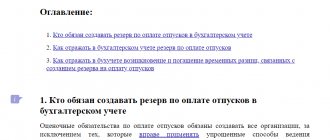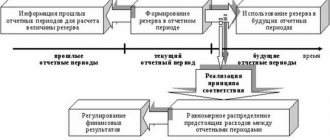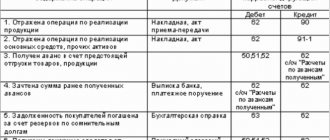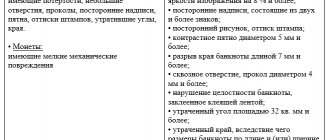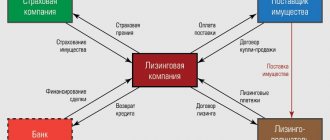Inventory of the reserve for vacation pay: sample
Before the formation of the final annual reports, an inventory of the reserve for vacation pay is carried out. The main goal of such an event is to identify amounts of overexpenditure or underuse of funds and adjust the tax base.
Inventory of the reserve for vacation pay - execution mechanism
The right of taxpayers to form vacation reserves is provided for by Stat. 324.1 NK. The accounting procedure for such transactions, including the monthly percentage and deduction limit, must be fixed in the accounting policy. According to current legislative norms, organizations are not required to use reservations, and those who work on a cash basis cannot take advantage of this benefit.
If the enterprise creates a reserve of vacation expenses, an inventory of obligations is mandatory under clause 3 of Art. 324.1 NK.
The need for a control assessment arises due to the fact that the amounts created by employees may not be fully used or, conversely, overspent.
At the same time, as of December 31, there is an excess of vacation pay actually issued to personnel over the reserve value, or the balance of the reserve is formed. Based on the results of adjustments, an accounting certificate or act is drawn up in any form.
Algorithm of actions for conducting an inventory of the vacation reserve:
- Approval by the manager of the order for the upcoming inventory of obligations, determining the duration of the event and the composition of the commission.
- Carrying out an inventory - data is compared in general for employees. If there are structural divisions, the check is performed for each division separately. Based on personnel and accounting information at the end of the year, the following are subject to determination: unused vacation days; average daily earnings; the amount of insurance premiums; the actual amount of the reserve for payment of unused vacation days as of December 31; the result of comparing the actual amount of the reserve and the created reserve (positive or negative difference).
- The final conclusion in the form of an act or accounting certificate.
Inventory of the reserve for vacation pay - sample
Let's assume that a trading company conducted an inventory of the vacation reserve as of December 31, 2016. Based on the results, it was determined that the amount of the reserve balance is 115,400 rubles. At the end of the year, there are 85 days of unused vacation days. The size of the average daily salary must be determined from the average monthly salary, which is equal to 35,700 rubles. The calculation is performed as follows:
- Average daily salary = 35,700 rubles. / 29.3 = 1218.43 rub.
- The actual calculated reserve amount = (1218.43 x 85) + (103567 x 30.2%) = RUB 134,844.23.
That is, the amount of the actual reserve consists of the summation of vacation and insurance premiums at a general rate of 30.2% (taking into account injuries of 0.2%).
Consequently, at the end of the year there is an excess between the pledged reserve and the actual one of 19,444.23 rubles. (134,844.23 – 115,400). Additional accrual for the next year is made by posting:
Source: https://digivi-cctv.ru/buhgalteru/inventarizaciya-rezerva-na-oplatu-otpuskov-obrazec
Income tax
If an organization creates a reserve for vacation pay, then all expenses associated with the payment of vacation pay are allocated to the use of the appropriate reserve (clause 2 of Article 324.1 of the Tax Code of the Russian Federation).
In tax accounting, do not include the amount of accrued vacation pay as expenses (clause 3 of Article 324.1 of the Tax Code of the Russian Federation). Instead, during the year, monthly contributions to the reserve for vacation pay can be taken into account as part of labor costs (Clause 24, Article 255 of the Tax Code of the Russian Federation).
For more information about this, see How to use the reserve for vacation pay and remuneration payments in tax accounting.
An example of reflection in accounting and taxation of operations for accruing vacation pay from the reserve for vacation pay
LLC "Proizvodstvennaya" in its accounting policy for accounting purposes and in its accounting policy for tax purposes has established:
- creating a reserve for vacation pay;
- calculation of monthly contributions to the reserve, taking into account contributions for compulsory pension (social, medical) insurance and insurance against accidents and occupational diseases;
- monthly percentage of contributions to the reserve in the amount of 8.6 percent;
- the maximum amount of contributions to the reserve for the year in the amount of 390,584 rubles.
The organization calculates contributions for insurance against accidents and occupational diseases at a rate of 0.8 percent.
In January and February, the wage fund (without vacation pay), taking into account insurance contributions, amounted to 299,880 rubles. for each month, including:
- 200,000 rub. taken into account on account 20 “Main production”;
- RUB 99,880 taken into account on account 26 “General business expenses”.
Also in January, production employees were accrued vacation pay in the amount of 21,000 rubles. Mandatory insurance premiums from this amount amounted to 6,468 rubles. (RUB 21,000 × (22% + 2.9% + 5.1% + 0.8%)).
In January and February, 25,789.68 rubles were added to the reserve. (RUB 299,880 × 8.6%) for each month.
Expenses for January vacation pay are greater than the reserve amount: (RUB 21,000 + RUB 6,468) > RUB 25,789.68.
The difference is 1678.32 rubles. (RUB 21,000 + RUB 6,468 – RUB 25,789.68).
The organization's accountant reflected the accrual of vacation pay with the following entries.
In January:
Debit 20 Credit 96 subaccount “Estimated obligation to pay for vacations” - 17,200 rubles. (RUB 200,000 × 8.6%) – deductions for January were made to the reserve for vacation pay from the salaries of employees of the main production;
Debit 26 Credit 96 subaccount “Estimated obligation to pay for vacations” - 8589.68 rubles. (RUB 99,880 × 8.6%) – deductions for January were made to the reserve for vacation pay from the salaries of management personnel;
Debit 96 subaccount “Estimated obligation to pay for vacations” Credit 70 - 21,000 rubles. – vacation pay for January accrued from the reserve is reflected;
Debit 96 subaccount “Estimated obligation to pay for vacations” Credit 69 – 6468 rub. – mandatory insurance premiums for January accrued from the reserve are reflected;
Debit 20 Credit 96 subaccount “Estimated liability for vacation pay” - 1678.32 - additional deductions were made to the reserve for vacation pay from the salaries of employees of the main production due to the fact that actual expenses turned out to be higher.
In February:
Debit 20 Credit 96 subaccount “Estimated obligation to pay for vacations” - 17,200 rubles. (RUB 200,000 × 8.6%) – deductions for February were made to the reserve for vacation pay from the salaries of employees of the main production;
Debit 26 Credit 96 subaccount “Estimated obligation to pay for vacations” - 8589.68 rubles. (RUB 99,880 × 8.6%) – deductions for February were made to the reserve for vacation pay from the salaries of management personnel.
Inventory of the reserve for vacation pay
The vacation reserve is a calculation of the costs that the company will have to face when paying for future vacations of its subordinates. Payments of compensation and contributions are also made from this reserve. But who is required by law to form such reserves? How often should this be done? And how is the reserve calculated?
Who needs to create a reserve?
Inventory of the reserve for vacation pay is permitted by law for all enterprises. This list does not include organizations that have the right to switch to a simplified form of accounting.
The purpose of such an inventory is the need to prove your solvency at the reporting date. In addition, the provision shows that the organization recognizes obligations to pay future vacation pay.
How often should a reserve be created?
The law requires the creation of a reserve on the reporting day. You can do this:
- the last day of each month, that is, each reporting day;
- the last day of each quarter;
- December 31, that is, once a year.
The last option will be relevant for those enterprises that prepare annual reports.
The day on which the reserve is created is approved by the accounting policy of the organization.
How is the reserve calculated?
An inventory of the reserve for vacation pay, a sample of which will be presented below, implies the inclusion not of actually accrued vacation pay amounts, but of monthly deduction amounts.
First you need to calculate the percentage of monthly deductions. The following formula is used for this:
x 100% = percentage of monthly deductions
The possible amount of expenses is approved by the accounting policy. This amount can be determined in the following ways:
- use information from last year;
- take into account the number of vacation pay planned for the year (you can use the vacation schedule) and the average earnings of employees.
The possible amount of expenses is the maximum amount of reserve contributions. This means that deductions must be made until their amount equals the limit.
The estimated amount of expenses for wages is also determined by several options:
- information for the previous year is taken into account;
- use salary data for the current year.
The second method will be relevant for enterprises where salaries consist of a salary component.
Potential labor costs may not include:
- vacation pay - in cases where the amounts of wages paid for the previous year are applied, all amounts of accrued vacation pay must be excluded;
- payments for individuals under civil law agreements.
The calculation of deductions made is drawn up in an internal document called an estimate.
Carrying out inventory in the enterprise
Inventory begins only on the basis of an order from the manager. The check includes the following steps:
- the volume of unused vacation days at the end of the year is determined;
- the reserve amount of insurance premiums and average daily earnings is calculated;
- the amount that needs to be paid for all unused vacations for the year is calculated, and the result is compared with the balance of the reserve;
- the results obtained are reflected in the accounting accounts.
Inventory entries for the reserve for vacation pay are filled in depending on the reserve balance. If the reserve balance is greater, then fill in the following entries:
- Dt 20, 23, 25, 26, 29 and 44;
- Kt 96.
In this case, an additional reserve for vacation pay occurs.
If the balance reserve is lower, then the following entries are filled in:
- Dt 20, 23, 25, 26, 29 and 44;
- Kt 96.
In this case, differences in expense amounts from the reserve are reversed.
Source: https://LawCount.ru/otchet/inventarizatsiya-rezerva-na-oplatu-otpuskov-obrazets/
Inventory of vacation reserve, sample
Account 96 “Reserves for future expenses”
Account 96 “Reserves for future expenses” is intended to summarize information about the status and movement of amounts reserved for the purpose of uniform inclusion of expenses in production costs and sales expenses. In particular, this account may reflect the following amounts:
- upcoming payment of vacations (including payments for social insurance and security) to employees of the organization;
- for the payment of annual remuneration for long service;
- production costs for preparatory work due to the seasonal nature of production;
- for repairs of fixed assets;
- upcoming costs for land reclamation and implementation of other environmental measures;
- for warranty repairs and warranty service.
Reservations of certain amounts are reflected in the credit of account 96 “Reserves for future expenses” in correspondence with the accounts of production costs and sales expenses.
Actual expenses for which a reserve was previously created are debited to account 96 “Reserves for future expenses” in correspondence, in particular, with accounts: 70 “Settlements with personnel for wages” - for the amount of wages to employees during vacation and annual remuneration for length of service; 23 “Auxiliary production” - for the cost of repairs of fixed assets carried out by a division of the organization, etc.
The correctness of the formation and use of amounts for a particular reserve is periodically (and necessarily at the end of the year) checked according to estimates, calculations, etc. and adjusted if necessary.
Analytical accounting for account 96 “Reserves for future expenses” is carried out according to separate reserves.
Account 96 “Reserves for future expenses” corresponds with the following Plan accounts:
by debit
- 23 “Auxiliary productions”
- 28 “Defects in production”
- 29 “Service industries and farms”
- 51 “Current accounts”
- 52 “Currency accounts”
- 69 “Calculations for social insurance and security”
- 70 “Settlements with personnel for wages”
- 76 “Settlements with various debtors and creditors”
- 91 “Other income and expenses”
- 97 “Deferred expenses”
- 99 “Profits and losses”
Inventory of the reserve for vacation pay
Each enterprise, if it has a staff of employees, is required to create a reserve for vacation pay. Exceptions include individual entrepreneurs and organizations operating under a simplified system.
Like any asset, reserves must be regularly monitored; for this, the company takes an inventory of the reserve for vacation pay. Today we will tell you how to properly organize this event.
The reserve created at the enterprise can be used to pay vacation pay, compensation for unused vacation, or pay contributions to funds from these accruals. Before preparing annual reports, an organization must conduct an inventory of all assets, including the reserve for vacation pay.
The creation of a fund must comply with the requirements of PBU 8/2010. The reserve can be formed monthly, quarterly or annually. The company must choose the most optimal option for it and indicate it in its accounting policy.
According to Order of the Ministry of Finance No. 49, in addition to property, reserve funds created at the enterprise are also subject to mandatory inventory. When assessing the reserve for vacation pay, it is necessary to clarify whether all planned vacation days were used by employees and how much the average salary has changed. These points directly affect the final result.
When assessing the reserve for vacation pay, it is necessary to clarify whether all planned vacation days were used by employees and how much the average salary has changed.
As with any inventory, it is first necessary to issue an order from the manager to conduct an audit, which clarifies the timing of the event and the inventory commission.
The reserve inventory work includes the following procedures:
- Identification of vacation days that employees did not use during the reporting period.
- Calculation of average wages and its analysis, because its change leads to an adjustment of the fund.
- Identification of the total amount required to pay unused vacations for all employees at the end of the year.
- Record the results of the audit in the accounting accounts.
At the end of the inspection, a report is filled out. We do not give an example or sample of it, since it is drawn up in any form. The developed form is fixed in the accounting policy. In addition, all calculations made during the event are attached to the document.
Based on the results of the inventory, appropriate entries are made in accounting.
If the reserve is insufficient, it is additionally accrued according to account CT 96, and if a surplus is identified, a reversal is also made according to account CT 96.
Carrying out an inventory of the created reserve funds at an enterprise is not difficult, but it is necessary to carry it out and formalize it accordingly.
Source: https://zhazhda.biz/base/inventarizaciya-rezerva-na-oplatu-otpuskov
Accounting for vacation reserves in 1C: ZUP
The choice of option for accounting for estimated liabilities in the 1C:ZUP 8.3 program for each organization is carried out in the accounting policy of the organization.
Fig.1 Setting up the calculation of vacation reserves
This setting defines:
- Will we create reserves in accounting (checkbox “In accounting”);
- If we create reserves in accounting, then whether we use the standard method or the “IFRS method” - we need to check the appropriate box;
- Will we write off excess accrued amounts monthly (checkbox “Revaluate monthly”);
- The amount of deductions as a percentage of the payroll: entered manually. The most common value is calculated as 100% divided by 12 months, which is about 8 percent;
- The maximum amount of deductions is applied when calculating estimated liabilities using the standard method. If reserves reach this value, then estimated liabilities are no longer accrued, and postings for holidays are formed at the expense of costs.
If an organization is a branch of another organization, then this setting is determined by the parent organization; it is not available for the branch.
Inventory of reserve for vacation pay sample
Formation of estimated liabilities and reserves for vacations in “1C: Enterprise 8” (Part II)
According to the estimate approved by the local act of the organization, the monthly percentage of contributions to the reserve is 8% of the payroll, and the maximum amount of contributions per year should not exceed 65,000 rubles. The organization is on the general taxation system and applies PBU 18/02 “Accounting for income tax calculations.”
The total rate of insurance premiums is 30%, the rate of contributions to the Social Insurance Fund for National Insurance and Social Security is 0.2%. Based on statements from employee Krasnova R.Z.
she was granted leave from April 13 to 15 and from July 1 to 31. Lyubavina P.P. no leave was provided during 2015.
In issue 8 (August) of the magazine “BUKH.1S” in tables 2 and 3 on p.
Reserve for vacation pay: inventory results
The article will discuss the reserve for upcoming expenses for vacation pay, the procedure for the formation and use of which is established by Art. 324.1 Tax Code of the Russian Federation.
For these purposes, the taxpayer is required to draw up a special calculation (estimate), which reflects the calculation of the amount of monthly contributions to the reserve, based on information about the estimated annual amount of expenses for vacations, including the amount of insurance premiums for such expenses.
In this case, the percentage of contributions to the reserve is determined as the ratio of the estimated annual amount of expenses for vacation pay to the estimated annual amount of labor costs.
Guided by this norm, as well as the provisions of paragraph.
Inventory of vacation reserve at the end of the year
Example 1.
Suppose manager Platonov P.P. annual basic paid leave of 28 calendar days was granted from September 30, 2021.
The amount of accrued vacation pay is RUB 28,000. (numbers are conditional). Vacation pay was paid on September 27.
When calculating income tax for 9 months of 2021, the organization will take into account vacation pay in the amount of 1000 rubles.
The “remainder” of vacation pay already applies to expenses in October 2021.
The company will take into account the amount of insurance contributions to extra-budgetary funds accrued for vacation pay in the period of their accrual.
That is, in the situation under consideration, they will be reflected in the income tax reporting for 9 months of 2021. The procedure for “working” with this data is described in Art.
The right not to create vacation reserves is given only to small businesses that are not issuers of publicly placed securities (clause
3 PBU 8/2010). All other organizations must reserve amounts for vacation pay in their accounting. The algorithm for reserving expenses for creating a vacation reserve must be fixed in the accounting policy of the organization for accounting purposes (clause 7 of PBU 1/2008). Sample wording to be inserted into an accounting policy for accounting purposes is given in example No. 1.
A similar reserve creation algorithm can be used for tax accounting purposes.
Inventory of the reserve for vacation pay (sample order)
should be included in the structure of costs for payment of work, and in the second - the negative difference should be included in the structure of non-operating profit.
If the taxpayer decides not to form a reserve for the next year, then the entire balance of the reserve must be included in income or expenses as of December thirty-first of the current year. The purpose of the inventory for vacation pay is to check whether the remaining balances are justified and “real.”
As part of the inventory, organizations must: Such calculations must be made by groups of employees, costs
Such adjustments should confirm the validity of the amount recorded in the accounting for future expenses for the payment of vacation pay.
Like any comparative check, inventory monitoring of the reserve for upcoming vacation expenses begins according to the order of the manager, which approves the composition of the inspection commission and the duration of the monitoring.
The inspection itself, mandatory at the end of the year, is carried out for employees of each department separately and consists of: For example, the inventory determined that at the end of the year the organization has a reserve balance for vacation payments of 139,400 rubles.
Reserve for vacation pay in tax accounting
! Please note: Organizations that use the cash method of recognizing income and expenses (under the simplified tax system or OSNO) do not take into account deductions for vacation pay in tax expenses and, accordingly, do not create such a reserve.
Source: https://admpravokumskoe.ru/inventarizacija-rezerva-na-oplatu-otpuskov-obrazec-87881/
Inventory of vacation reserve at the end of the year
In tax accounting, unlike accounting, creating a reserve for upcoming expenses for vacations is the right of the organization, and not an obligation. This is explained primarily by the fact that the purposes of creating a “vacation” reserve in accounting and tax accounting differ. It is necessary to reflect the estimated obligation to pay for vacations in accounting so that users of the financial statements are presented with a real picture of the company’s financial condition. In turn, in tax accounting, vacation pay is “reserved” in order to evenly account for vacation expenses throughout the year. At the same time, at the end of the year it is necessary to conduct an inventory of this reserve. And the procedure for accounting for the results of this event depends on whether the vacation pay will continue or whether it will refuse to create this reserve.
The provisions of Ch. 25 of the Tax Code (hereinafter referred to as the Code) provides for two options for accounting for vacation payments for profit tax purposes.
Inventory of vacation reserve
Topic: Vacation reserve (Vacation reserve), Vacation pay accounting (Vacation reserve).
If the company has not previously used a vacation reserve, read the page About the first vacation inventory.
Additionally: Download the “Accountant's Handbook”
On what date is the vacation reserve inventory ?
According to paragraph 7 of the Regulations on the inventory of assets and liabilities, approved by order of the Ministry of Finance of Ukraine No. 879 dated 02.09.
How to calculate vacation inventory
When forming a “vacation” reserve, actually paid vacation pay and the corresponding amounts of insurance premiums are written off from this reserve.
Write-offs are made until the amount of the reserve accrued since the beginning of the year reaches the maximum amount of contributions to the reserve - from this moment on, no contributions to the reserve are made.
Note! Compensation for unused vacation and insurance premiums accrued on them cannot be written off from the reserve for future expenses for vacation pay (see Letter of the Ministry of Finance dated May 3, 2012 N 03-03-06/4/29).
The specified amounts are taken into account as part of labor costs in the general manner (clause 8 of Article 255 of the Tax Code). So, throughout the year, the organization writes off vacation expenses evenly. At the same time, no adjustments are made to the “reserve” calculations either in connection with the dismissal of personnel or in connection with the hiring of new employees.
Inventory of the reserve for vacation pay (sample)
In other words, when forming a reserve, an enterprise proceeds from the assumption that it will be used during the reporting year. Thus, the provision of vacations should be reflected exclusively in line 1660 “Current liabilities”. The notes to the financial statements disclose information about:
- the purpose of the reserve, the reasons for the uncertainty of the amount or timing of repayment and the expected period of its repayment;
- the balance of collateral at the beginning and end of the reporting period;
- collateral adjustments;
- the amount of collateral used during the reporting period;
- unused amount of collateral canceled during the reporting period.
Small businesses, except for those who keep simplified records of income and expenses, in the Balance Sheet (f.
No. 1-m)4 reflect the security on line 430.
Inventory of the reserve for vacation pay (sample order)
Part of the amount is due to vacation days not used by 2 employees (one employee did not take 5 days of vacation, the other did not take 10 days).
Let's assume that the average daily wage for these employees as of December 31 of the current year was 600 rubles, then unused vacation days account for 9,000 rubles. (600 RUR x 15 days).
Insurance premiums and deductions for injuries will amount to 2,718 rubles.
(RUB 9,000 x 30.2%).
Inventory of the vacation reserve in accounting at the end of the year
For example, the inventory determined that at the end of the year the organization has a reserve balance for vacation payments of 139,400 rubles. 115 calendar person-days of vacation were not used. The average salary per month is 27,570 rubles. The calculated amount of the reserve will be 141,755 rubles: The formation of a reserve for vacation pay is mandatory in accordance with the rules set out in PBU 8/2010 “Estimated liabilities, contingent liabilities and contingent assets”, approved by Order of the Ministry of Finance of Russia dated December 13, 2010 N 167n. In accordance with the “Guidelines for the inventory of property and financial liabilities”, approved by Order of the Ministry of Finance of the Russian Federation dated June 13, 1995 N 49, estimated liabilities are necessarily inventoried.
So, throughout the year, the organization writes off vacation expenses evenly. At the same time, no adjustments are made to the “reserve” calculations either in connection with the dismissal of personnel or in connection with the hiring of new employees. At the same time, the amount of monthly contributions to the reserve depends on the size of actual labor costs. In addition, vacation pay for new employees, which was not included in the calculation, is also written off from the reserve. The percentage of contributions to the “vacation” reserve is determined as the ratio of the estimated annual amount of expenses for vacation pay to the estimated annual amount of labor costs. In this case, both of these indicators are taken taking into account the corresponding amounts of insurance premiums.
